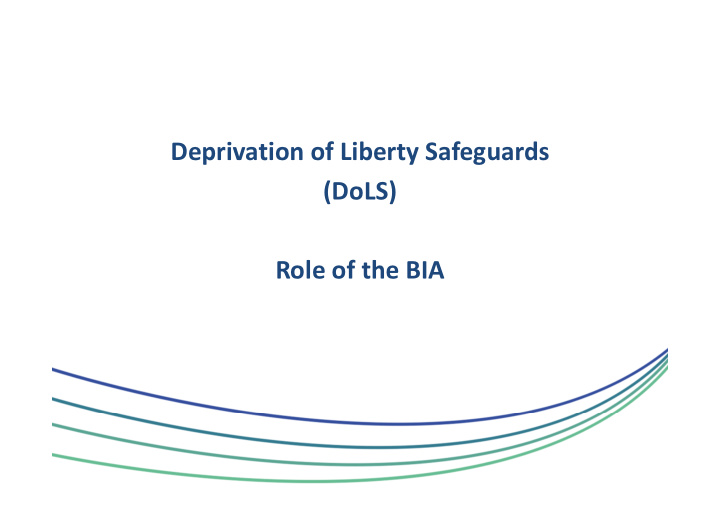



Deprivation of Liberty Safeguards (DoLS) Role of the BIA
Who will DoLS apply to? The deprivation of liberty safeguards will cover people in hospitals, and people in care homes registered under the Care Standards Act 2000, whether placed under public or private arrangements
Requests • The Managing Authority (care home or hospital) requests authorisation to the Supervisory Body (the Local Authority who made the arrangements for care homes and the Local Authority where the Relevant Person is ordinary resident) • Request for Standard Authorisation – planned admissions – 21 days • Request for Urgent Authorisation – emergency admissions – 7 days (can extend to 14 if needed)
Assessment Criteria • Age – 18+ • Mental Disorder – any disorder of the mind or brain MHA83 • Lack of Capacity. • Eligibility – is the Mental Health Act more appropriate? Risk to others? • No Refusals. • Best Interests. • Assessments are completed by a Best Interests Assessor (BIA) and Mental Health Assessor (MHA) (Section 12 Dr)
SIGNATORY/ Supervisory Body BIA Care Manager Managing Authority PERSON
Trained BIA’s In order to become a BIA, you need the following • - Social worker, Nurse, Psychologist, Occupational Therapist with over 2 years post qualification experience, - Complete a post grad course at a university – 6 weeks (comparison – AMHP – course is over a year) - Yearly legal update required for BIA’s - Halton in 2014 – 9 trained BIA’s - Halton in June 2019 – 28 trained BIA’s - Areas of concern - When the Managing Authority is the same as the Supervisory Body (care homes owned and managed by Halton Borough Council), the BIA needs to be someone who isn’t employed by the LA (3.21 of the DoLS Code of Practice)
Mental Capacity • Stage One: What is the impairment of, or disturbance in the functioning of the mind or brain? • Stage Two: (functional test); • The person is unable to understand the information relevant to the decision • The person is unable to retain the information relevant to the decision • The person is unable to use or weigh that information as part of the process of making the decision • The person is unable to communicate their decision • Stage Three: Explain why the person is unable to make the specific decision because of the impairment of, or disturbance in the functioning of, the mind or brain.
No Refusals Assessment • To the best of my knowledge and belief the requested Standard Authorisation would not conflict with an Advance Decision to refuse medical treatment or a decision by a Lasting Power of Attorney, or Deputy, for Health and Welfare. • To the best of my knowledge and belief the requested Standard Authorisation would conflict with an Advance Decision to refuse medical treatment or a decision by a Lasting Power of Attorney, or Deputy, for Health and Welfare. • There is not a valid Advance Decision, Lasting Power of Attorney or Deputy for Health and Welfare in place.
Best Interests Assessment BACKGROUND INFORMATION • VIEWS OF THE RELEVANT PERSON • VIEWS OF OTHERS • ACID TEST: Do they meet the acid test of continuous (or complete) supervision AND • control AND are not free to leave. The placement is imputable to the State. It is necessary to deprive the person of their liberty in this way in order to • prevent harm to the person. Describe the risks of harm to the person that could arise which make the deprivation of liberty necessary. Support this with examples and dates where possible. Include severity of any actual harm and the likelihood of this happening again. Depriving the person of their liberty in this way is a proportionate response to • the likelihood that the person will otherwise suffer harm and to the seriousness of that harm. With reference to the risks of harm described above explain why deprivation of liberty is justified. Detail how likely it is that harm will arise (i.e. is the level of risk sufficient to justify a step as serious as depriving a person of liberty?). Why is there no less restrictive option? What else has been explored? Why is depriving the person of liberty a proportionate response to the risks of harm described above?
Best Interests Assessment This is in the person’s best interests. • Remember that the purpose of the person’s deprivation of liberty must be • to give them care or treatment. You must consider whether any care or treatment can be provided effectively in a way that is less restrictive of their rights and freedom of action. You should provide evidence of the options considered. In line with best practice this should consider not just health related matters but also emotional, social and psychological wellbeing. Option 1: • Benefits and Burdens • Option 2: • Benefits and Burdens • The reasons for choosing this period of time are: Please explain your • reason(s) RECOMMENDATIONS AS TO CONDITIONS •
Selection of Representative • I have selected and recommend that the Supervisory Body appoints the representative identified below. In so doing I confirm that: • the person this assessment is about (who may have capacity but does not wish to select a representative) and / or their Donee or Deputy does not object to my recommendation; • the proposed representative agrees to act as such, is eligible, and would in my opinion maintain contact with the person, represent and support them in matters relating to or connected with the Standard Authorisation if appointed . ( Read guidance notes for clarification of eligibility). • PAID Relevant Persons Representative.
Authorisation • Signatory from Supervisory Body (HBC). • Scrutinises assessments to see if legal criteria met. • Agrees conditions. • Agrees time period. • Gives authorisation on behalf of Supervisory Body.
LPS SIGNATORY/DM BIA/AMCP CM MA PERSON
Any questions?
Recommend
More recommend